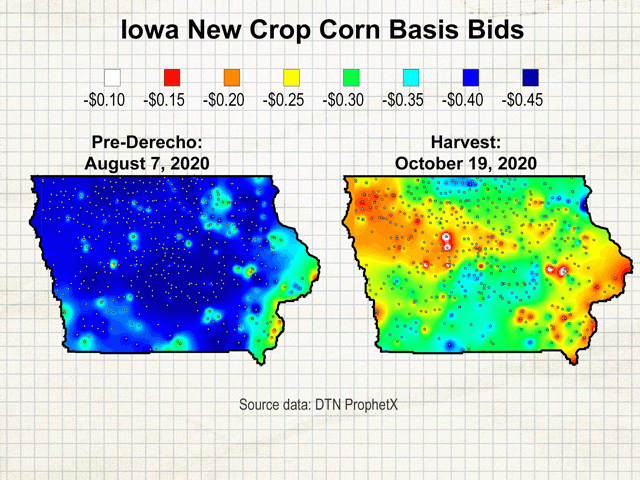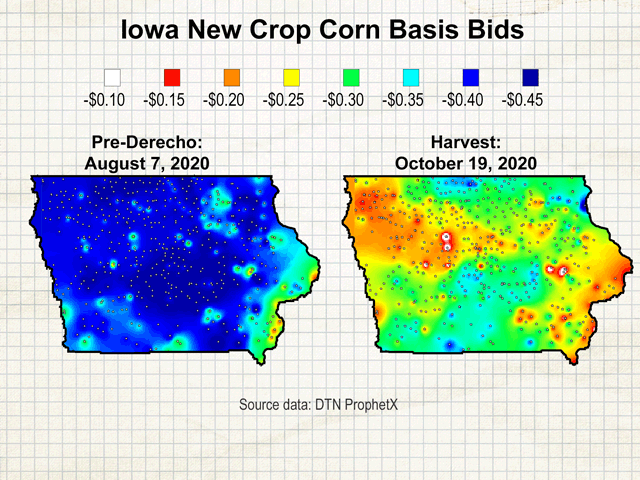Ag Weather Forum
Effects of August Derecho on Iowa Corn Basis Still Linger
Back in the height of summer, here's what a central-Iowa grain elevator was bidding for new-crop corn:
-- On Aug. 7, 2020: 40 cents under the December 2020 futures contract.
Ultimately, here's what that elevator was actually paying for corn at the gut slot of harvest:
-- On Oct. 19, 2020: 10 cents under the December 2020 futures contract.
The first example, from Aug. 7, reflects what the elevator originally thought it would be paying for newly harvested corn this fall, before the derecho storm on Monday, Aug. 10, flattened fields and crumpled grain bins, before the summer ended too dry to optimally fill soybean pods and before the Chinese feed importers went on a buying spree. Then, the derecho happened, and the local basis market became a big question mark.
P[L1] D[0x0] M[300x250] OOP[F] ADUNIT[] T[]
There were two schools of thought: Some worried that with all the bin damage on farms and at large commercial elevators, the lack of storage space would put pressure on the local grain markets once the bulk of harvested bushels were trying to find a home, depressing local basis bids that were already weaker than usual due to an ethanol slump. Others felt the yield losses from the storm damage would be widespread enough to cause some scarcity in the local grain markets, forcing basis bids to move stronger as each elevator tried to source grain by outcompeting its neighbors.
The gut slot of harvest has now passed (Iowa's corn was 65% harvested as of Oct. 18 and 87% harvested in the most recent USDA NASS Crop Progress report on Nov. 2), and we can examine the evidence to see what really happened to the local basis after that scenario of simultaneous storage losses and production losses.
It looks like the latter school of thought has definitely won out. The production losses have more than made up for the storage losses, and local basis bids in Iowa have grown hot and competitive. The realization played out gradually, with local new-crop basis bids strengthening about 5 cents in the week immediately after the derecho storm but not cranking up to full competitiveness until harvest began at the end of September and it became clear that the farmers just wouldn't bring in their corn bushels any other way.
In fact, according to USDA analysis, despite the August derecho damage, Iowa was still showing a surplus of grain storage capacity (http://dx.doi.org/…) relative to their combined Sept. 1 grain stocks and projected 2020 production. Elevators with storm-damaged bins either scrambled to get them fixed or quickly made contingency plans to use ground piles or grain bags. Iowa's storage surplus, in fact, is two standard deviations above its five-year average, and when storage is abundant, harvest pressure tends to have less effect on farmers' and merchandisers' decisions about how urgently they need to move grain.
Now, while elevators may feel able to take in the grain, they're finding they have to post competitive bids to do so, especially for corn. In an environment where the cash price for soybeans is generally above $10.00 per bushel across the majority of Iowa, commercial grain merchandisers are finding that farmers are more likely to sell their soybeans to cover fall cash needs, fill their own on-farm bins with corn, then shut those bin doors tight in the belief that local scarcity will keep prices high for the foreseeable future.
These marketing choices are being shared by farmers across a broader geography, muddying the picture of where exactly the derecho damage may have caused the most severe patches of local scarcity. A map showing how new-crop basis bids have evolved into unseasonably strong spot bids now that harvested grain is coming to market shows considerable strength in Cedar Rapids, of course, where the derecho winds were strongest (over 120 miles per hour) and the damage was most severe, but also in other pockets in the state of Iowa where there may not have been immediate derecho damage but there was subsequent drought stress to the crops.
Farmers are notorious for letting their marketing be influenced by "backyarditis," but in the topsy-turvy year of 2020, the view out across an Iowa backyard has indeed been a market mover.
Elaine Kub is the author of "Mastering the Grain Markets: How Profits Are Really Made" and can be reached at masteringthegrainmarkets@gmail.com.
(c) Copyright 2020 DTN, LLC. All rights reserved.






Comments
To comment, please Log In or Join our Community .